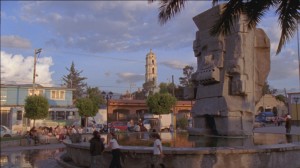Sandra Rozental did her PhD research in the town of Coatlinchán in the municipality of Texcoco, just outside of Mexico City. As an anthropologist, the time she spent there and digging around in archives is not surprising– anthropologists do that sort of thing. She was on the trail of a story about how knowledge, history, and ownership were caught up in modernist Mexican nationbuilding of the 1960s, and how they still are. The resulting research is quite good and I’d recommend her articles to anyone interested, but that’s not what I want to write about.
I want to tell you about her film, “La Piedra Ausente.” In English, it’s “The Absent Stone.”
Produced in partnership with Jesse Lerner, it is not an ethnographic piece exactly. It’s a documentary, and seems more of an ethnographic analogue to me. It’s– ok, I’m a sucker for beautiful complicated film, even if I am not a film person, per se. This is incredible.
It’s particularly worth looking at for fans of cinema, of Mexico, and, possibly most relevant here, for academics thinking about the media in which they might render their work.
Made of archival footage, animation, and interviews with Coatlinchán locals and the engineers and architects who took their stone away, the film is about an ancient carved rock. The rock, transported by radical new feats of engineering to be displayed in the National Museum of Anthropology in Mexico City, became just as much a symbol of Mexico’s modern patrimony and industry as of its prehispanic past.
The documentary tells a good story: the largest carved stone produced in the ancient Americas, referred to as either the god Tlaloc or the goddess Chalchiuhtlicue, was in Coatlinchán, half finished and a bit broken, until the mid 1960s. Its removal to Mexico City in 1964 provoked an uprising, or something like one, and an armed intervention. The stone is still remembered in Coatlinchán, in such visual representations as the replica below.
Something really good happened here, something which stands on its own as a piece of film. It is enjoyable in its own right and informative in its own ways. This film shows a non-didactic commitment to rendering people talking history, talking identity, talking technology and knowledge and ownership, that is really complex and unapologetically ambivalent.
Here’s the trailer. See it if you get the chance. Are there other academic/public crossover pieces that inspire you? What do you think makes for a good one?

